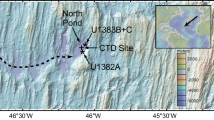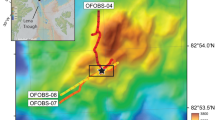Abstract
STEADY-STATE emanations of hydrothermal vent fluid along the mid-ocean ridges give rise to plumes rising 100–300 m above the sea floor, identified by anomalies of temperature, conductivity, chemistry and particles. Recently, a quite different type of hydrothermal plume created by a brief but massive release of high-temperature hydrothermal fluids was discovered by Baker et al. at a Juan de Fuca vent field1–3. This gigantic thermal plume was termed a 'megaplume'. In December 1987, we found a large hydrothermal plume showing anomalies of temperature, methane and manganese above the North Fiji Basin spreading axis. The transience of this plume at 173° 30′ E, 18° 50′ S was confirmed by our return visit to the site in November 1988. The discovery of megaplumes at two sites in very different tectonic environments indicates that this type of hydrothermal activity may make an important contribution to thermal and chemical fluxes from the mid-ocean ridges.
This is a preview of subscription content, access via your institution
Access options
Subscribe to this journal
Receive 51 print issues and online access
$199.00 per year
only $3.90 per issue
Buy this article
- Purchase on Springer Link
- Instant access to full article PDF
Prices may be subject to local taxes which are calculated during checkout
Similar content being viewed by others
References
Cann, J. & Strens, R. Nature 329, 104 (1987).
Baker, E. T., Massoth, F. J. & Feely, R. A. Nature 329, 149–151 (1987).
Lupton, J. E., Baker, E. T. & Massoth, G. J. Nature 337, 161–164 (1989).
Auzende, J. M. et al. Tectonophysics 146, 317–351 (1988).
Swinbanks, D. Nature 328, 4 (1987).
Auzende, J. M. et al. C. r. hebd. Séanc. Acad. Sci., Paris. Ser. 2 306, 971–978 (1988).
Klinkhammer, G. & Hudson, A. Earth planet Sci. Lett. 79, 241–249 (1986).
Charlou, J. L., Rona, P. & Bougault, H. J. mar. Res. 45, 461–472 (1987).
Jones, C. J., Johnson, H. P. & Delaney, J. R. Geophys. Res. Lett. 8, 873–876 (1981).
Craig, H., Craig, V. K. & Kim, K. R. Eos 68, 100–101 (1987).
Von Damm, K. L. et al. Geochim. cosmochim. Acta 49, 2197–2220 (1985).
Winn, C. D., Karl, D. M. & Massoth, G. J. Nature 320, 744–746 (1986).
Von Damm, K. L. & Bischoff, J. L. J. geophys. Res. 92, 11334–11346 (1987).
Baker, T. E. & Massoth, G. J. Science 234, 980–982 (1986).
Rosenberg, N. D. et al. Nature 334, 604–607 (1988).
Ishibashi, J. et al. Geochem. J. 22, 107–114 (1988).
Author information
Authors and Affiliations
Rights and permissions
About this article
Cite this article
Nojiri, Y., Ishibashi, Ji., Kawai, T. et al. Hydrothermal plumes along the North Fiji Basin spreading axis. Nature 342, 667–670 (1989). https://doi.org/10.1038/342667a0
Received:
Accepted:
Issue Date:
DOI: https://doi.org/10.1038/342667a0
This article is cited by
-
Niche partitioning of hydrothermal vent fauna in the North Fiji Basin, Southwest Pacific inferred from stable isotopes
Marine Biology (2022)
-
Generation of hydrothermal megaplumes by cooling of pillow basalts at mid-ocean ridges
Nature (1998)
-
Active spreading and hydrothermalism in North Fiji Basin (SW Pacific). Results of Japanese French Cruise Kaiyo 87
Marine Geophysical Researches (1990)
Comments
By submitting a comment you agree to abide by our Terms and Community Guidelines. If you find something abusive or that does not comply with our terms or guidelines please flag it as inappropriate.



